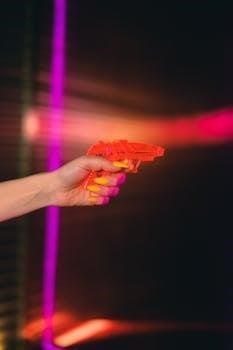
pop to the shops game instructions

Game Setup
The first step in setting up the game is to assemble the jigged game board and place it in the center of the playing area, ensuring all pieces are correctly connected, creating the path for the players․
Each player then selects a character and places it into a character stand․ They also each take a shopping bag board which will serve as their personal area to collect items during the game․
Finally, each player is given a starting amount of play money, typically consisting of two 50p coins, two 20p coins, and one 10p coin․ The remaining coins are placed in the center to form the bank․
Assembling the Board
To begin the setup of the “Pop to the Shops” game, the first crucial step involves carefully assembling the jigged game board․ This board is typically made up of several interlocking pieces that need to be connected to form a complete path․ Ensure that all the pieces are properly aligned and interlocked to create a stable and continuous playing surface․ This assembled board will serve as the foundation for the game, providing the visual representation of the various shops that players will visit during the game․ The board depicts a colorful route that players will follow, moving their characters from shop to shop․ This initial step is vital to ensure smooth gameplay and accurate movement for all participants․ Taking the time to properly assemble the board is essential for a successful and enjoyable game session․ This setup phase is crucial before the actual gameplay commences․ It ensures the board is ready for players to navigate;
Preparing Player Components
Once the game board is fully assembled, the next phase of setup involves preparing the individual player components․ Each player begins by choosing a character figurine, which is then placed into a corresponding character stand, ensuring the figure can stand upright․ This character will represent each player as they move around the board․ Additionally, every player takes one shopping bag board, which will act as their personal collection area for the items they purchase throughout the game․ These shopping bag boards are designed to resemble shopping bags and will hold the item cards․ Each player’s shopping bag board should be placed in front of them, within easy reach․ This setup ensures that each player has their own designated space and character for the duration of the game, ready for the main gameplay to begin․ These components are essential for each player’s participation and tracking progress․
Distributing Starting Money
After each player has their character and shopping bag board, the next crucial step is to distribute the starting money․ Each player receives a specific set of play money to begin their shopping journey․ This usually consists of two 50p coins, two 20p coins, and one 10p coin․ This initial distribution ensures that all players have equal starting funds to make purchases during the game․ The remaining play money, which is not distributed to the players, is then placed in a central location to form the bank․ This central bank will be used to make change and collect payments as players purchase items․ The bank should be easily accessible to all players throughout the game․ The specific allocation of play money to each player is intended to mirror real-world shopping scenarios, where players have a limited budget to begin with, introducing a basic element of financial management in a fun and simple way․ This preparation allows each player to start purchasing items from the shops․

Gameplay
Players take turns rolling a dice to move their character around the game board, navigating between the various shops, in order to reach the ones they need․
Moving Around the Board
Each player’s turn begins with a roll of the dice, which determines how many spaces their character will move along the board․ The board is designed with various shops, each offering different items for purchase․ Players must strategically move their character to reach the shop that sells the item they need on their shopping list, which will be a randomly selected item card․ The path to each shop isn’t always direct, adding a slight element of strategy to the movement․ Remember that a player must shake at least twice to get to a shop․ Each turn involves only one shake of the dice․ If a player doesn’t have enough money to buy the item, they pick again․ After purchasing the item, they return to their own shop doorway․ This process is repeated until a player successfully collects their items․
Purchasing Items
When a player lands on a shop that sells an item they need, they can purchase the item using their play money․ Each item has a specific price, which is indicated on the item card․ Players must pay the correct amount to the ‘banker’ or the shopkeeper, which may be another player․ If a player does not have the exact amount, they must give the next amount and receive change․ When they have enough money to buy an item, they take the item card and place it on their shopping bag board․ After purchasing an item they must return to their own shop doorway․ Players must also say “please” and “thank you” to the shopkeeper each time they buy something․ If a player does not have the correct amount of money, they must pick again until they have enough․
Handling Money and Change
During gameplay, players will need to use the provided play money to purchase items from the various shops on the board․ Each item has a designated cost, and players must pay the exact amount or give a larger sum and receive change back․ Players must be able to count out the correct amount of money from their supply to pay for their chosen item․ When a player buys an item, they give the correct amount of money to the banker or shopkeeper․ If they give too much money, the banker or shopkeeper must provide the correct change to the player․ This involves calculating the difference between what was paid and the item’s price․ This aspect of the game will help children learn to calculate change, which will develop their mathematical skills․ The remaining coins are kept in the center of the board․

Winning the Game
The first player to successfully collect six different item cards on their shopping bag board is declared the winner of the game․ This concludes the gameplay session․
Collecting Six Items
The primary objective of the game revolves around being the first player to acquire a total of six unique item cards and place them onto their respective shopping bag board․ This is achieved by strategically moving your character around the board, landing on various shops, and making purchases using the provided play money․ The item cards represent different goods available for sale at the shops and are essential for achieving victory․ Players must carefully plan their route and manage their finances to ensure they can obtain all the required items․ The challenge lies in efficiently navigating the board, making smart purchasing decisions, and being the first to complete their shopping list, showcasing their money handling skills and ability to adapt to the game’s dynamics․ Each turn involves dice rolls, movement, and potential transactions, adding an element of chance and strategy to the race for six items․

Educational Aspects
This game teaches children about handling money, giving change, and making purchasing decisions, using play money to simulate real-world transactions at different shops on the board․
Players also develop counting skills as they move around the board, count their money, and keep track of the number of items they have collected on their shopping bag board․
Learning Money Skills
This game provides an engaging way for children to learn essential money skills by simulating a real-world shopping experience․ Players handle play money, making them familiar with different coin values like 50p, 20p, and 10p․ They learn to count out the correct amount of money needed to purchase items from different shops on the game board․ The game also introduces the concept of giving change, as players may need to receive back some coins after a purchase, further enhancing their understanding of basic transactions․ Additionally, players take on the roles of both shoppers and shopkeepers, giving them a practical feel for money handling from different perspectives, while they must also learn when they have enough money to buy the items they need․ This hands-on approach makes learning about money fun and memorable for young children․
Developing Counting Abilities
The game “Pop to the Shops” is designed to enhance children’s counting abilities through various gameplay elements․ Players move their 3D characters around the board by rolling a die, requiring them to count the number of spaces to advance․ This reinforces their ability to count sequentially and understand the numerical value of the die roll․ Furthermore, the game involves counting money, both when making purchases and when giving or receiving change, which provides additional practice in number recognition and counting skills․ As they collect items, players also need to count how many they have on their shopping bag boards, working towards the goal of collecting six items․ The game integrates counting into various tasks, making it a fun and natural way to develop these important numerical skills․